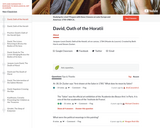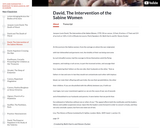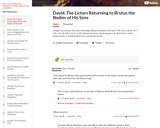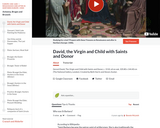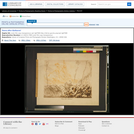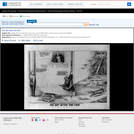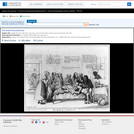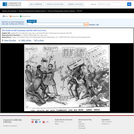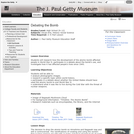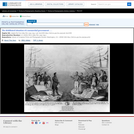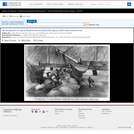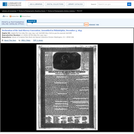In his satire Johnston celebrates the defeat of "Loco Foco," i.e., radical Democratic interests, in the presidential election of 1840. The "Loco Focos" were the largely working-class constituency who supported Van Buren's antimonopoly, antispeculative fiscal agenda whose centerpiece was the Independent Treasury (or "Sub Treasury") Bill. A Midas-like figure, with beard and ass's ears, writhes in his last agony on a bed. In his hand he grasps the "Sub Treasury" bill. Surrounding him are several prominent Democrats (left to right): Andrew Jackson (in a woman's dress), Francis Preston Blair, Levi Woodbury, Martin Van Buren, Thomas Hart Benton, Amos Kendall, and John Calhoun. Jackson, wringing his hands: "O dear! to think that I should have nursed him with so much care, to see him now cut off in the prime of life! . . ." Woodbury: "This will be a dreadful shock to the country!" Blair: "To the "country!!" it's enough to make a man fly his country & seek an asylum amongst the bloodhounds of Cuba . . ." The Van Buren administration's introduction of Cuban bloodhounds to hunt Indians in the Second Seminole War provoked considerable public outrage and congressional concern early in 1840. (See "The Secretary of War," no. 1840-5). Kendall: "Doctor Humbug is this really a case of Typus?" Benton: "It is so called by some, whilst others call it "Tip'" us. The majority have decided however that it is both "Tip and Ty."" The reference is to William Henry Harrison, christened "Old Tippecanoe" for the campaign, and his running-mate John Tyler. Calhoun: ". . . The loss of my last patient Nullification is fresh in the memory of all men, and now Locofocoism . . . In short I must "once" more change my system or give up practice." Calhoun, a staunch anti-Jackson force in the Senate, reversed himself in 1837 to support Van Buren's fiscal program. Several remedies are on the bed table, including "Dr. Duncan's soporific," "Benton drops," "(Globe) Extra," "Treasury Pap," and "Poinsett's [i.e., Secretary of War Joel Poinsett's] Indian pills." A devil peers in the window at right. At left, through an open door, are visible a street musician singing, "Van, Van Is a used up man" and a girl crying, "Buy a broom a Harrison broom."|Entered . . . 1840 by James Fisher.|Published by James Fisher, no. 71 Court St. Boston.|Signed: Whigsby del (David Claypool Johnston).|The Library's impression was deposited for copyright on November 13, 1840. |Title appears as it is written on the item.|Helfand, p. 7.|Johnson, no. 157.|Weitenkampf, p. 65.|Forms part of: American cartoon print filing series (Library of Congress)|Published in: American political prints, 1766-1876 / Bernard F. Reilly. Boston : G.K. Hall, 1991, entry 1840-64.
